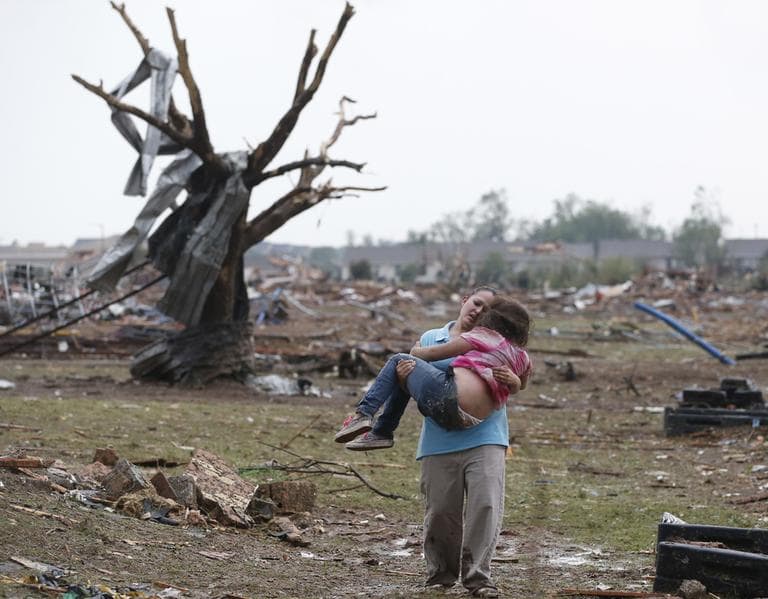Advertisement
How Can We Better Prepare For Tornadoes?
ResumeAfter Oklahoma’s giant twister, does Tornado Alley need to change the way it builds and lives in the age of superstorms?

When the tornado warnings came to Moore, Okla. this week, people rushed to shelter where and how they could. Teachers and kids into school bathrooms and closets. A coach had his high school team put on their football helmets. Bank employees ran into the vault.
And then, the epic destruction. So much just blown away.
Could we build and prepare better for the threat in Tornado Alley? Or are tornadoes so random that it doesn’t add up?
Up next On Point: The re-engineering question — Oklahoma’s giant twister and whether Tornado Alley needs to change the way it builds.
-- Tom Ashbrook
Guests
Heide Brandes, Oklahoma City journalist reporting on Moore's tornadoes for the Wall Street Journal. (@HeideWrite)
Harold Brooks, research meteorologist at the National Oceanic and Atmospheric Administration’s National Severe Storms Laboratory.
Jeff Barber, certified architect and a housing and environmental design specialist at the University of Missouri Extension. He was a consultant to Joplin, Mo. following the city's 2011 tornado and advised on tornado-proofing infrastructure and community preparedness. He also worked for the first FEMA Community Storm Shelter in Missouri, following the 2003 Pierce City tornadoes.
Michael Fitzgerald, independent journalist who has recently wrote on national disaster preparedness, including a look at Moore, Okla. — "Money Spent Beforehand Blunts The Impact Of Disasters" and "Tornado Veterans Balance Preparedness, Practicality." (@riparian)
From Tom's Reading List
The Oklahoman: Rolling Coverage
CNN: What You Need To Know About Tornadoes
The Atlantic: Tornadoes In America: The Oklahoma Disaster In Context — "The simple answer is that warm, moist air from the Gulf of Mexico gets sandwiched between war, dry continental air and cold, dry air from drifting down from the Rockies. The combination creates the perfect conditions for thunderstorms to form...As these air masses collide, they can generate a type of particularly dangerous thunderstorm called a "supercell." They are characterized by their very strong, rotating updrafts accompanied by strong downdrafts. Tornadoes tend to occur at the interface between these two air movements."
TIME: For Republicans, Oklahoma Tornado Revives Questions About Disaster Relief — "Congressional Republicans on Tuesday were thrust into the tricky position of balancing their desire to help the reeling residents of Moore, Okla., with their recent zeal for deficit reduction. It may seem “crass,” as Coburn’s spokesman put it, to focus on political calculations as rescue crews pick through the wreckage of a tragic storm that left at least 24 dead. But politics can hamper the speed and success of the recovery efforts after tragedies like this."
The New York Times: A Survival Plan For America’s Tornado Danger Zone -- "The horror confronting residents and emergency workers probing the tornado wreckage in Oklahoma is unimaginable for those of use elsewhere. Collapsed schools, disintegrated homes, crushed cars and more. The main focus should be on aid. But it’s worth beginning a conversation about ways to live safer in such hazard zones given that this storm season is just getting under way and that big regions of America’s tornado hot zone have deep vulnerability resulting from runaway growth and a human tendency to discount threats that have a low probability but disastrous potential. (The same issues are driving exposure to danger in hurricane zones.)"
Tweets From During The Show
[storify url="http://storify.com/OnPointRadio/oklahoma-superstorm-preparation" width="500"]
This program aired on May 22, 2013.